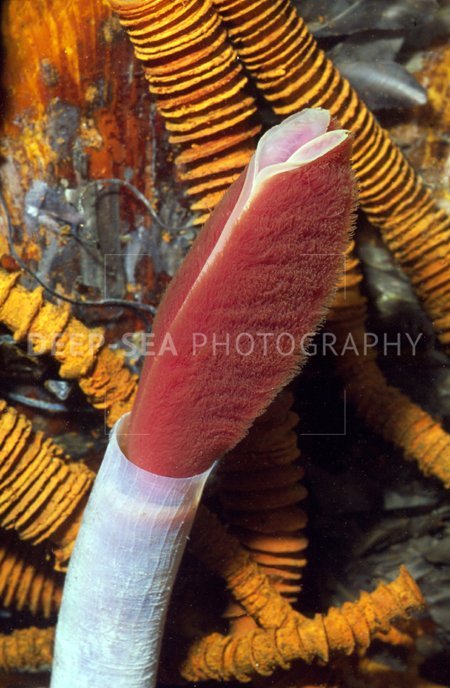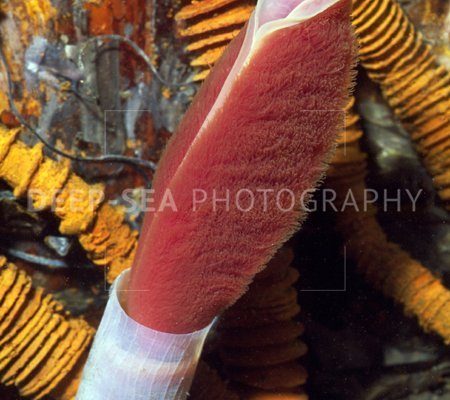
Identifying a Riftia pachyptila can feel like hunting for treasure on a vibrant ocean floor. These worms are known for their vibrant, bushy tops that resemble a plume of feathers. They dwell near hydrothermal vents, where hot, mineral-rich water spews from the Earth’s crust. Understanding how to find them can not only make your next deep-sea adventure more rewarding but can also help you appreciate the unique ecosystem they represent. So, grab a cup of your favorite brew, and let’s dive deep into the world of these oceanic wonders!
Understanding the Habitat of Riftia Pachyptila
Riftia pachyptila thrives in some of the earth’s most extreme environments—hydrothermal vents. These places are like the deep-sea version of a bustling café. They’re teeming with life, fueled by the heat and nutrients released from the Earth’s interior. The vent communities are often found along mid-ocean ridges—think of them as underwater mountain ranges where tectonic plates pull apart.
You might be wondering, “What’s so special about these vents?” Well, they create a unique ecosystem where sunlight is absent, and organisms rely on chemosynthesis instead of photosynthesis. This means that instead of using sunlight to produce energy, organisms like Riftia pachyptila depend on bacteria that convert the chemicals released by the vents into energy. It’s a beautiful example of life adapting to its environment.
When looking for Riftia pachyptila, keep in mind that they usually form dense clusters in these hydrothermal habitats. Imagine a cozy neighborhood of tube worms nestled against rugged rocks, all tightly packed together. This clustering is essential for their survival, as it helps them share resources and protect each other from predators.
Physical Characteristics of Riftia Pachyptila
If you’re on the lookout for Riftia pachyptila, you’ll want to know what they look like. These tube worms can grow quite large—up to 3 meters (almost 10 feet) long! Their bodies consist of a long, tube-like structure that is usually white or pale in color, forming a protective home for the creature. The top of the tube is adorned with vibrant red or orange plumes, which are actually their gills. This colorful display makes them easier to spot against the deep blue of the ocean.
Their plumes serve a specific purpose: they help the worm absorb chemicals from the water to survive. These gills are rich in specialized bacteria that convert methane and hydrogen sulfide into energy. So, when you see tall, bushy structures waving in the currents, you’re likely looking at a thriving community of Riftia pachyptila!
Another distinguishing feature is their lack of a mouth or digestive system. Instead, they rely completely on their symbiotic bacteria for nourishment. It’s almost like having a roommate who takes care of all the cooking while you focus on enjoying life in your cozy home.
Where to Find Riftia Pachyptila
Finding Riftia pachyptila isn’t as easy as taking a stroll down a coral reef. These fascinating organisms are usually located at depths ranging from 1,200 to 2,500 meters (about 4,000 to 8,200 feet) below sea level. You’ll typically find them clustered near hydrothermal vents on the ocean floor.
To spot them, you would likely need to venture out with specialized equipment, like a remotely operated vehicle (ROV) or a submersible. This gear helps researchers and adventurers dive deep to capture images and gather data about these unique ecosystems. If you’ve ever seen stunning underwater footage from deep-sea explorations, chances are, you’ve caught a glimpse of Riftia pachyptila thriving in their habitat.
Look for distinct signs of hydrothermal activity, such as rising clouds of mineral-rich water or patches of bright colors on the seafloor. These signals can lead you to a community of tube worms. Also, pay attention to the temperature of the water, as these worms prefer warm water conditions, typically around 50°C (122°F).
The Role of Riftia Pachyptila in Their Ecosystem
Riftia pachyptila plays a vital role in its ecosystem. By hosting symbiotic bacteria, they contribute significantly to the energy flow in their environment. When these bacteria convert chemicals from the vent into energy, they become the primary food source for other organisms, essentially forming the foundation of a unique food web.
In addition to that, their presence indicates the health of the hydrothermal vent communities. The more robust and diverse a population of Riftia pachyptila, the healthier the ecosystem surrounding them. This makes them essential for scientists studying environmental changes and the resilience of deep-sea habitats.
Moreover, the clusters of Riftia pachyptila create habitats for various other marine species. Small fish, crustaceans, and even other invertebrates often take shelter among the tube worms, finding a safe haven in their dense communities. It’s like a bustling city, where everyone contributes to the local economy and ecosystem.
Challenges Facing Riftia Pachyptila
Unfortunately, Riftia pachyptila face several threats due to human activity. Fishing practices, mining, and climate change can dramatically affect their delicate habitats. For example, deep-sea mining can destroy hydrothermal vents and, with them, the communities that thrive around them.
Climate change also poses a significant threat. As ocean temperatures rise and acidification occurs, the very chemistry that supports these tube worms and the bacteria they depend on is altered. If we want to enjoy the beauty of these organisms and their habitats, we must work together to protect them from further damage.
Researchers are actively studying these challenges to understand better how to conserve these unique ecosystems. By raising awareness about the importance of hydrothermal vent communities, we can help ensure their survival for generations to come.
How to Study and Observe Riftia Pachyptila
If you’re interested in observing Riftia pachyptila, consider joining deep-sea exploration programs or participating in research expeditions. Many organizations offer opportunities for citizen scientists, where you can learn and contribute to ongoing studies about these fascinating creatures.
Before heading out, familiarize yourself with the gear needed for deep-sea exploration. There’s specialized equipment designed for underwater observation, including ROVs, that allow for safe and effective observation of these organisms in their natural habitat.
While studying them, it’s crucial to maintain a respectful distance. These are delicate ecosystems, and interactions should be minimized to avoid disruption. Taking photos or recording videos can be a great way to document your findings while ensuring the creatures remain undisturbed.
Identifying a Riftia pachyptila in its natural habitat is not just about spotting a strange worm; it’s about understanding a whole ecosystem that thrives in one of Earth’s harshest environments. These tube worms remind us of life’s incredible adaptability, offering insight into how organisms can not only survive but flourish in conditions that seem impossible.
As you think about taking a dive into the deep ocean, remember that every little observation contributes to a bigger picture of life on Earth. So, next time you hear someone talk about deep-sea wonders, you’ll have an excellent starting point to share your knowledge about the magnificent Riftia pachyptila!

